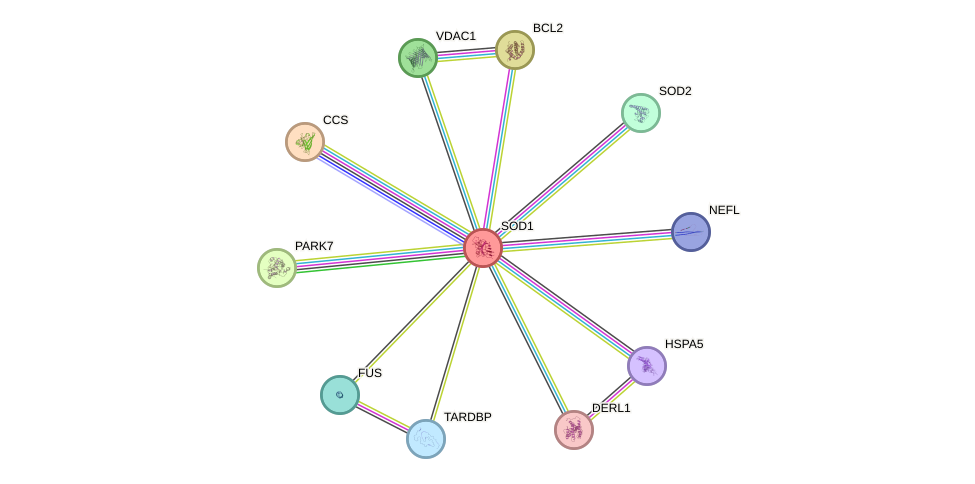GenAge entry for SOD1 (Homo sapiens)
Gene name (HAGRID: 130)
- HGNC symbol
- SOD1
- Aliases
- IPOA; ALS; ALS1
- Common name
- superoxide dismutase 1, soluble
Potential relevance to the human ageing process
- Main reason for selection
- Entry selected based on evidence directly linking the gene product to ageing in a non-mammalian animal model
- Description
SOD1 is an antioxidant. It is the predominant member of the SOD family found in the cytoplasm. Initial results from invertebrates suggested a role for SOD1 in ageing. Overexpression of SOD1 and CAT in short-lived strains of fruit flies extends lifespan and appears to delay ageing [39], but the same effects are not witnessed in long-lived strains [40].
Early SOD1-null mice models were found to develop normally and did not show signs of premature ageing, though they were vulnerable to motor neuron loss after axonal injury [45]. In a more recent study the kidneys of SOD1-null mice exhibited increased DNA damage, increased senescent cells, and increased inflammation. Subjecting these mice to dietary restriction attenuated these effects [4485]. SMP30RGN/SOD1-double knockout mice exhibit abnormal plasma lipid metabolism, hepatic lipid accumulation and premature death resulting from impaired VLDL secretion, both compared to wild type, SMP30-knockout and SOD1-knockout mice [3618]. Overexpression of human SOD1 in transgenic mice results in neurodegenerative changes [663]. In humans, mutations in SOD1 have been associated with amyotrophic lateral sclerosis [671]. A role for SOD1 in human ageing, while not impossible, remains to be determined.
Cytogenetic information
- Cytogenetic band
- 21q22.11
- Location
- 31,659,622 bp to 31,668,930 bp
- Orientation
- Plus strand
Protein information
- Gene Ontology
-
Process: GO:0000187; activation of MAPK activity
GO:0000302; response to reactive oxygen species
GO:0000303; response to superoxide
GO:0001541; ovarian follicle development
GO:0001819; positive regulation of cytokine production
GO:0001890; placenta development
GO:0001895; retina homeostasis
GO:0001975; response to amphetamine
GO:0002262; myeloid cell homeostasis
GO:0002576; platelet degranulation
GO:0006749; glutathione metabolic process
GO:0006801; superoxide metabolic process
GO:0006879; cellular iron ion homeostasis
GO:0007283; spermatogenesis
GO:0007566; embryo implantation
GO:0007569; cell aging
GO:0007605; sensory perception of sound
GO:0007626; locomotory behavior
GO:0008089; anterograde axonal transport
GO:0008090; retrograde axonal transport
GO:0008217; regulation of blood pressure
GO:0009408; response to heat
GO:0010033; response to organic substance
GO:0019226; transmission of nerve impulse
GO:0019430; removal of superoxide radicals
GO:0031667; response to nutrient levels
GO:0032287; peripheral nervous system myelin maintenance
GO:0032930; positive regulation of superoxide anion generation
GO:0033081; regulation of T cell differentiation in thymus
GO:0034465; response to carbon monoxide
GO:0035865; cellular response to potassium ion
GO:0040014; regulation of multicellular organism growth
GO:0042493; response to drug
GO:0042542; response to hydrogen peroxide
GO:0042554; superoxide anion generation
GO:0043065; positive regulation of apoptotic process
GO:0043085; positive regulation of catalytic activity
GO:0043087; regulation of GTPase activity
GO:0043524; negative regulation of neuron apoptotic process
GO:0045471; response to ethanol
GO:0045541; negative regulation of cholesterol biosynthetic process
GO:0045859; regulation of protein kinase activity
GO:0046620; regulation of organ growth
GO:0046677; response to antibiotic
GO:0046688; response to copper ion
GO:0046716; muscle cell cellular homeostasis
GO:0048538; thymus development
GO:0048678; response to axon injury
GO:0050665; hydrogen peroxide biosynthetic process
GO:0051881; regulation of mitochondrial membrane potential
GO:0055114; oxidation-reduction process
GO:0060047; heart contraction
GO:0060052; neurofilament cytoskeleton organization
GO:0060087; relaxation of vascular smooth muscle
GO:0060088; auditory receptor cell stereocilium organization
GO:0071276; cellular response to cadmium ion
GO:0071318; cellular response to ATP
GO:0072593; reactive oxygen species metabolic process
GO:0097332; response to antipsychotic drug
GO:1902177; positive regulation of oxidative stress-induced intrinsic apoptotic signaling pathway
Cellular component: GO:0005576; extracellular region
GO:0005615; extracellular space
GO:0005634; nucleus
GO:0005654; nucleoplasm
GO:0005737; cytoplasm
GO:0005739; mitochondrion
GO:0005758; mitochondrial intermembrane space
GO:0005759; mitochondrial matrix
GO:0005764; lysosome
GO:0005777; peroxisome
GO:0005829; cytosol
GO:0005886; plasma membrane
GO:0031012; extracellular matrix
GO:0031045; dense core granule
GO:0031410; cytoplasmic vesicle
GO:0032839; dendrite cytoplasm
GO:0043025; neuronal cell body
GO:0043209; myelin sheath
GO:0043234; protein complex
GO:0070062; extracellular exosome
GO:1904115; axon cytoplasm
Hide GO termsFunction: GO:0004784; superoxide dismutase activity
GO:0005507; copper ion binding
GO:0005515; protein binding
GO:0008270; zinc ion binding
GO:0030346; protein phosphatase 2B binding
GO:0042802; identical protein binding
GO:0042803; protein homodimerization activity
GO:0048365; Rac GTPase binding
GO:0051087; chaperone binding
Protein interactions and network
- Protein-protein interacting partners in GenAge
- TXN, PIN1, BCL2, CAT, SOD2, SOD1, PRDX1, RGN, HSPA9, PCMT1, HSPA8, RAE1, STUB1, GPX4, TRAP1
- STRING interaction network
Retrieve sequences for SOD1
Homologs in model organisms
- Caenorhabditis elegans
- sod-5
- Danio rerio
- sod1
- Drosophila melanogaster
- Sod
- Mus musculus
- Sod1
- Rattus norvegicus
- Sod1
- Saccharomyces cerevisiae
- SOD1
- Schizosaccharomyces pombe
- sod1
In other databases
- GenAge model organism genes
- GenDR gene manipulations
- A homolog of this gene for Saccharomyces cerevisiae is present as SOD1
- LongevityMap
- This gene is present as SOD1
- CellAge
- This gene is present as SOD1

